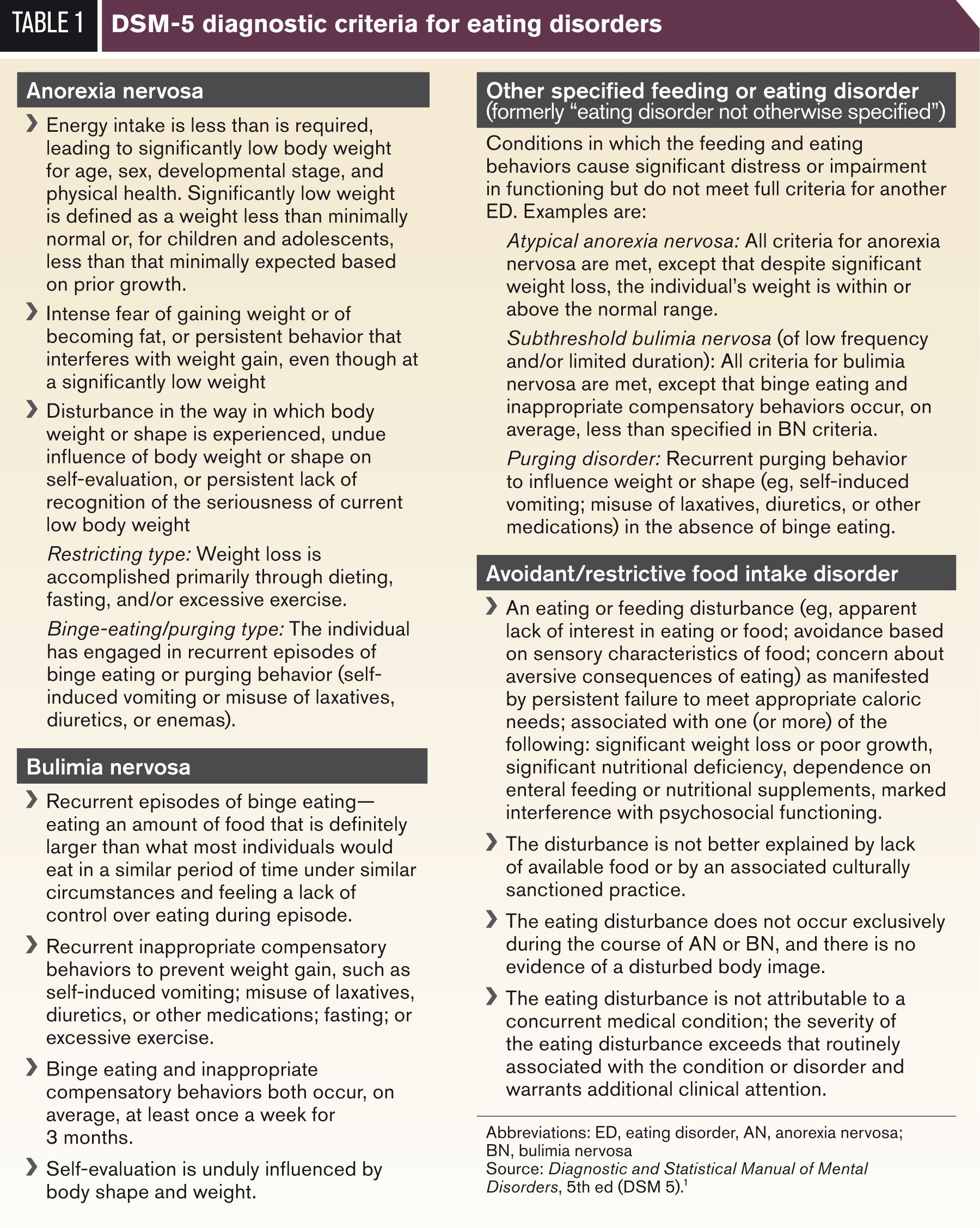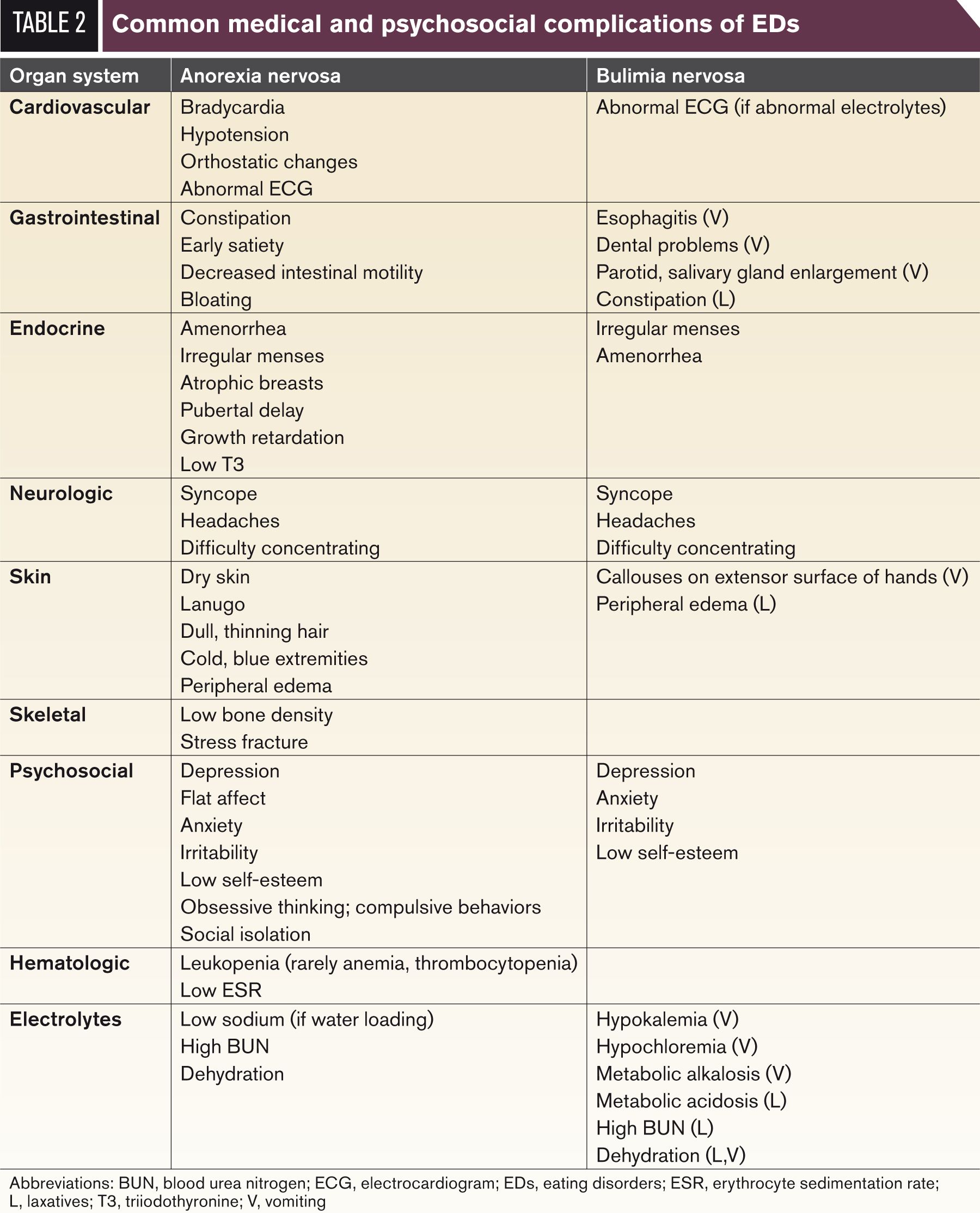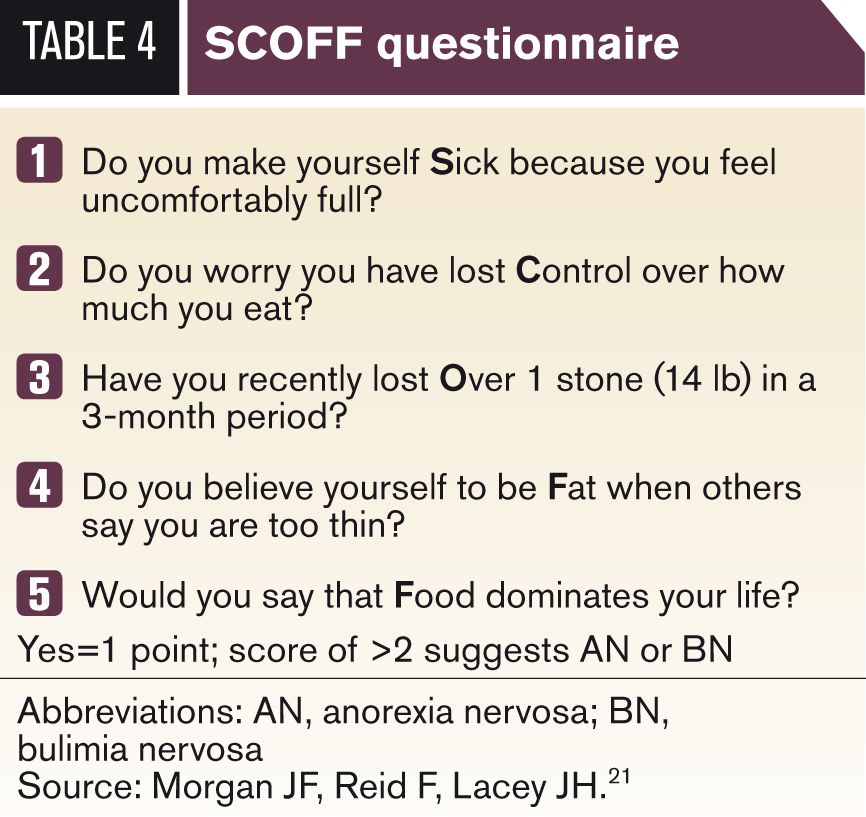Eating disorders in adolescents and young adult women: Implications for reproductive health
Eating disorders develop in vulnerable individuals from an interplay of genetics and a host of personality and sociocultural factors. Healthcare providers should be mindful of red flags for eating disorders in adolescents and young women.
Dr. Snyder is Chief of Adolescent Medicine and Clinical Associate Professor of Pediatrics at Rutgers Robert Wood Johnson Medical School, New Brunswick, New Jersey.
She has no conflict of interest to disclose with respect to the content of this article.

The North American Society for Pediatric and Adolescent Gynecology (NASPAG) is a nonprofit organization dedicated to educating healthcare professionals in pediatric and adolescent gynecology. For more information, visit www.naspag.org.
Eating disorders (EDs) are serious, often debilitating chronic illnesses that typically start in adolescence. About 90% of ED patients are female. In addition to anorexia nervosa (AN) and bulimia nervosa (BN), the most recent Diagnostic and Statistical Manual of Mental Disorders
(DSM-5) has included binge eating disorder.1 Past DSM editions included the category “eating disorder not otherwise specified” (EDNOS), and many young people fell into this group. Modifications of the other ED criteria and the addition of the category “other specified feeding or eating disorder” led to the elimination of EDNOS. Avoidant/restrictive food intake disorder (ARFID) is one more new category; it is especially relevant for children and adolescents. Table 1 outlines the DSM-5 ED criteria.1

The prevalence of EDs has increased in recent decades, likely due in part to better recognition as well as the marked medical and societal focus on obesity and dieting. Current prevalence estimates among adolescents and young adults in the United States are 0.5% to 1.0 % with AN, 1% to 2% with BN, and about 5% with other EDs.2 Of special concern is that ED diagnoses are increasingly being made in preadolescents (<12 years), putting this young population at heightened risk for delayed physical and psychosocial development.3 These prevalence figures are clearly underestimates. The 2011 Youth Risk Behavior Surveillance, a biannual national survey of high school students by the Centers for Disease Control and Prevention, found 61% of females were trying to lose weight, and in the past 30 days 12% of females had not eaten for 24 hours or more, 5% took diet pills/supplements, and 4% induced vomiting or took laxatives to lose or not gain weight.4 Thus, many young women are engaging in unhealthy eating and dieting behaviors, even if they do not meet DSM criteria for an ED.
EDs can affect every organ system; patients may present with any combination of gynecologic, cardiac, gastrointestinal, neurologic, orthopedic, or psychiatric signs and symptoms (Table 2). Young women with EDs are seldom forthcoming about their ED thoughts and behaviors, often leading to unnecessary testing and delayed diagnosis. Because of parental concerns, children and adolescents may be more likely to see a healthcare provider earlier in their course than are older patients.

EDs are multifactorial in origin, with a strong genetic component.3,5 They are not volitional, although dieting often precedes the ED. Patients with AN at low weight show elevated ghrelin, a hunger-stimulating hormone secreted mainly by the stomach and pancreas, and a low level of leptin, a hormone secreted by adipocytes. These abnormalities are likely a physiologic adaptation to a starved state, rather than causal. A constellation of personality and psychologic traits such as perfectionism and low self-esteem are often but not always seen in those with EDs. Comorbid psychiatric conditions, especially anxiety and depression, are common.6 Again, are these factors causative or more a result of the disordered eating and weight changes? Our thinness-obsessed culture influences everyone; young women seem to be especially vulnerable to unrealistic and unattainable “body ideals,” and yet few develop an ED.
Menstrual irregularities
Primary care providers and gynecologists see many adolescent and young women with primary or secondary amenorrhea or irregular periods. Although the differential diagnosis of menstrual irregularities is vast in this age group, EDs need to be near the top of the list. Because the patient with an ED will rarely disclose her eating or weight-control behaviors, it is incumbent on the practitioner to be aware of red flags that suggest an ED as the cause of her menstrual problem (Table 3).
Amenorrhea
For the first time, DSM 5 did not include amenorrhea as one of the criteria for the diagnosis of AN. Reasons for the change included that previous criteria precluded premenarchal girls or those on hormonal contraception from receiving the diagnosis of AN. Amenorrhea occurs in more than 90% of those with AN and as many as 50% of those with BN and other specified eating disorders.7,8
Numerous mechanisms are believed to be involved in causing amenorrhea. Gonadotropin-releasing hormone (GnRH) pulsatility is lost (reverting to a prepubertal pattern), with resultant decrease in follicle-stimulating hormone (FSH) and luteinizing hormone (LH) secretion, ovarian suppression, and estradiol levels. Hypoleptinemia seems to also play a role in hypothalamic-pituitary-ovarian axis suppression.8 Puberty and menarche may be delayed in those girls whose ED began prior to the expected time of puberty. Secondary amenorrhea can occur even before there is significant weight loss. Although weight/body mass index (BMI) are critical factors in menstrual irregularities, amenorrhea can occur even in those at normal weight or overweight, regardless of the specific ED diagnosis.9

Clinicians, patients, and parents often want to know when menses will return. Return of menses is viewed as a marker of biologic health and is typically used as a treatment goal (rather than a specific weight). Being within a normal weight range is clearly necessary, but not sufficient. Research has identified the following predictors for return of menses: within 6 months of achieving 90% of expected body weight (EBW); weight at which menses stopped plus 5 lb; serum estradiol level of greater than 30 pg/mL; and BMI at 15% to 20% for age.10,11
Persistent amenorrhea can also be seen in those who are exercising intensely, purging frequently (vomiting, laxative abuse), or showing marked fluctuations in their weight. An obese young woman who loses 40 lb to weigh 180 lb can develop the same menstrual irregularities as one who started out normal weight and became underweight. It is likely that ongoing dieting and psychosocial stressors also contribute to menstrual irregularities, although the mechanisms are unknown.8
A subset of women with EDs meets criteria for the female athlete triad: disordered eating, amenorrhea, and low bone mineral density (BMD). Girls at highest risk for this constellation of signs and symptoms are those doing long-distance running, gymnastics, figure skating, or ballet. For some, the weight loss starts in an attempt to improve performance or at the urging (direct or indirect) of a coach or teacher, but then the behaviors become compulsive or excessive. The resultant hypoestrogenemic state, along with intense physical activity, puts these young women at increased risk for stress fractures-thus outweighing any benefit that weight-bearing exercise has for bone health.12
Irregular menses
At least half of women with BN have irregular menses, even though they are not underweight, and half had a history of amenorrhea.13 Researchers have found that factors independently associated with irregular menses include higher frequency of vomiting, lower total thyroxine (T4), and lower fat intake. At 12-month follow-up, 43% still had irregular periods. These women had a greater discrepancy between their maximum and minimum weights, longer duration of ED symptoms, and were more depressed.13
In a nonclinical sample of high school students, investigators found that 15% of the young women had periods less than once a month (their definition of “irregular”).14 Those who reported vomiting 1 to 3 times a month to control their weight were 1.5 times more likely to have irregular periods than those who did not vomit. Girls who vomited more than once weekly were more than 3 times as likely to have irregular menses. The menstrual irregularity was explained by the frequency of purging, not by the girls’ weight.
Girls diagnosed with the newest DSM category, ARFID, can be underweight and have delayed puberty or secondary amenorrhea. Often they do not seem to have an eating disorder; they may state that they are too thin and want to gain weight but have a variety of reasons that prevent this-such as being excessively picky eaters; history of choking/gagging with fear of that happening again; and a fear of vomiting or abdominal pain if they eat more. Lack of recognition or awareness of this entity can lead to missed diagnosis and delays in care.
Other sequelae of eating disorders
Effect on bone
Peak bone mass is influenced by race, genetics, physical activity, calcium and Vitamin D intake, and gonadal steroids, among others. The hypoestrogenemia commonly seen in those with AN has an adverse effect on bone mineralization. Because adolescence is when approximately one-half of final bone mass is acquired, ED-associated amenorrhea is especially deleterious for bone health.15 Low BMD can occur after as little as 6 months of amenorrhea and is seen in at least half of AN patients. These young women are at increased risk for pathologic fractures. There is growing concern that, even with a return to healthy weight and resumption of menses, normal peak bone mass may never be achieved, thus placing these women at long-term risk for fractures.
In contrast to postmenopausal women, the low BMD seen in adolescents and young women with EDs is a result of both increased bone resorption and decreased bone formation. Multiple factors are believed to be involved in ED-associated bone loss: hypoestrogenemia, relative hypercortisolemia, hypoleptinemia, decreased insulin-like growth factor 1 (IGF-1), vitamin and micronutrient deficiencies, and decreased muscle mass.15,16
BMD is typically assessed by dual-energy x-ray absorptiometry (DXA). DXA scans in children and adolescents must be interpreted using appropriate reference data. T scores should not be used, as this compares the patient’s BMD to that of young adults (at peak bone mass). Rather, Z scores, based on age- and gender-matched controls, should be calculated to correctly interpret the DXA. Appropriate terminology for abnormal BMD in children and adolescents is “low BMD for age,” rather than “osteopenia” or “osteoporosis.” Although there is ample evidence that low BMD in an adolescent is a significant risk for stress fracture, the BMD fracture threshold for adolescents and young adults has not been established.
Numerous strategies to improve bone density in ED patients have been tried, and this remains an active area of research. Most of these trials involved hormone replacement, either combination oral contraceptive pills (OCPs) or conjugated estrogens. OCPs have not been shown to significantly prevent or reverse low BMD in this population.15 Furthermore, it is not uncommon for these young women on hormonal therapy to interpret regular withdrawal bleeding as proof that they are fine and do not need to gain weight or stop their weight-control behaviors.
In a placebo-controlled trial, investigators demonstrated that physiologic estradiol replacement (given transdermally) improved spine and hip BMD in adolescent AN patients.16 The authors suggest that this treatment was effective because physiologic doses of estrogen do not suppress IGF-1, whereas the relatively high estrogen dose found in OCPs does suppress IGF-1. Of note, no difference was observed between treated and untreated girls in weight gain or lean or fat mass. Thus, physiologic doses of transdermal estrogen may help prevent ED-associated low BMD, especially in those girls who fail to gain weight and re-establish menses in spite of nutritional and psychologic therapy.
Trials of bisphosphonates have shown mixed results; these are not recommended to treat low BMD in young ED patients. Long-term safety data in young people are lacking; of special concern are these drugs’ long half-life, potential to be released from bone years later, and ability to cross the placenta.
The only certain effective “treatment” for ED-associated low BMD is nutritional rehabilitation, weight gain to a healthy range, and resumption of spontaneous menses.17,18
Effect on fertility
Although future fertility may not be an immediate issue for adolescents, it may be a concern for them later. While amenorrheic, a woman is highly unlikely to get pregnant, but there have been reports of women with AN conceiving. Patients seen in an infertility clinic were screened and then interviewed to detect EDs.19 Nearly 17% met criteria for AN, BN, or EDNOS. Almost 60% of those with a history of amenorrhea or oligomenorrhea had an ED, but none had disclosed their ED behaviors to their ob/gyn. Women who recover from EDs do not seem to have an increased risk of infertility.20
When to suspect an ED
Because it is common for young women to hide or minimize being overly concerned with weight, dieting, eating behaviors, and exercise habits, healthcare providers should be mindful of common red flags (Table 3). It is also common for ED patients to deny they have a problem when asked about their eating behaviors and dieting. Practitioners will be more successful when questions are asked honestly and nonjudgmentally. Several well-validated ED screening questionnaires exist, but these are not practical for use in an office setting.
On the other hand, the SCOFF questionnaire is brief and easy to use, although it has not been validated in adolescents (Table 4).21

Adolescents with menstrual irregularities should be asked routinely about their weight history (maximum and minimum in the past year); eating habits, including typical daily intake; if they purge (vomit, take diet pills or laxatives); and their exercise habits.
Physical exam findings that may suggest an ED include: weight and BMI less than 15% for age; bradycardia; low blood pressure; and orthostatic changes in heart rate or blood pressure. Patients with AN may have very dry skin, dry and thinning hair, lanugo, breast atrophy, and cold and blue hands and feet. Swollen parotid or submandibular glands and dental problems (eg, eroded dental enamel, caries) may be seen in those who are purging. Other than low weight in patients with AN, however, most patients with EDs will have a normal exam.
Making the diagnosis of an ED
No laboratory study either diagnoses or rules out an eating disorder. Some abnormalities are common and due to malnutrition (such as low white blood cell count; low total triiodothyronine (T3) with normal thyroid-stimulating hormone; and low FSH, LH, and estradiol). Laboratory testing is helpful when ruling out other diagnoses (eg, pregnancy, polycystic ovary syndrome) or when looking for acute complications of the ED (eg, electrolyte abnormalities due to purging). A thorough and sensitive history and careful physical exam (including getting an accurate weight) are the most important diagnostic tools.
NEXT: MANAGEMENT AND PROGNOSIS >>
Management
Detailed discussion of treating ED patients is beyond the scope of this article. Most patients can be treated as outpatients; optimal treatment is provided by a team that includes a medical provider, dietician, and mental health professional. General treatment goals are to help the patient restore and maintain a healthy weight and nutritional status, identify and cope with any psychosocial issues that contributed to the ED, and establish healthful eating. Studies have demonstrated improved outcomes with early intervention and family involvement in treatment.
Numerous psychotropic medications have been tried and studied in this patient population.22 Selective serotonin reuptake inhibitors (SSRIs) have not been shown to help with weight gain in patients with AN, although these agents may help with comorbid anxiety or depression. More recently, atypical antipsychotics, especially olanzapine, have been tried, with mixed results. In contrast, SSRIs have been shown to decrease the frequency of binging and purging in patients with BN. Fluoxetine is the only FDA-approved medication for the treatment of BN.
Hospitalization is indicated for patients with severe medical or psychiatric signs or symptoms. Several professional organizations have established guidelines for hospitalization.3,23,24
Prognosis
Most adolescents and young adults eventually recover from their EDs, although the course is often bumpy and may last years.25 Some patients will have a resolution of one type of ED (such as AN) and then, sometimes abruptly, develop the characteristics of a different type (such as BN). AN has the highest mortality rate of any psychiatric diagnosis, with patients usually dying from suicide or complications of the ED (eg, arrhythmia).26
Summary
Eating disorders develop in vulnerable individuals from an interplay of genetics and a host of personality and sociocultural factors. They are associated with high rates of morbidity and mortality and have especially deleterious medical and developmental effects on children and adolescents. Menstrual disturbances are very common and may be associated with nonreproductive sequelae such as bone loss. Effective treatment requires nutritional rehabilitation to achieve a healthy weight and psychologic help with underlying emotional issues. Optimal treatment is provided by an interdisciplinary team and includes the family.
References
1. American Psychiatric Association. Diagnostic and Statistical Manual of Mental Disorders, 5th ed (DSM 5). Arlington, VA: American Psychiatric Press; 2013.
2. Swanson SA, Crow SJ, LeGrange D, et al. Prevalence and correlates of eating disorders in adolescents. Results from the national comorbidity survey replication adolescent supplement. Arch Gen Psychiatry. 2011;68(7):714–723.
3. Rosen DS; American Academy of Pediatrics Committee on Adolescence. Identification and management of eating disorders in children and adolescents. Pediatrics. 2010;126(6):1240–1253.
4. Centers for Disease Control and Prevention. Youth Risk Behavior Surveillance-United States, 2011. MMWR. 2012;61(4):1–162. http://www.cdc.gov/mmwr/pdf/ss/ss6104.pdf. Accessed February 12, 2014.
5. Striegel-Moore RH, Bulik CM. Risk factors for eating disorders. Am Psychol. 2007;62(3):181–198.
6. Hudson JI, Hiripi E, Pope HG Jr, Kessler RC. The prevalence and correlates of eating disorders in the National Comorbidity Survey Replication. Biol Psychiatry. 2007;61(3):348–358.
7. Pinheiro PA, Thornton LM, Plotonicov KH, et al. Patterns of menstrual disturbance in eating disorders. Int J Eating Disord. 2007;40(5):424–434.
8. Vyver E, Steinegger C, Katzman DK. Eating disorders and menstrual dysfunction in adolescents. Ann N Y Acad Sci. 2008;1135:253–264.
9. Payne AE, Jacobson MT, Carlson JL, Peebles R. Physiological and behavioral predictors of amenorrhea in normal-weight adolescents with eating disorders. J Pediatr Adolesc Gynecol. 2011;24(2):e71.
10. Golden NH, Jacobson MS, Schebendach J, et al. Resumption of menses in anorexia nervosa. Arch Pediatr Adolesc Med. 1997;151(1):16–21.
11. Dempfle A, Herpertz-Dahlmann B, Timmesfeld N, et al. Predictors of the resumption of menses in adolescent anorexia nervosa. BMC Psychiatry. 2013;13:308.
12. AAP Committee on Sports Medicine and Fitness. Medical concerns in the female athlete. Pediatrics. 2000;106(3):610–613.
13. Gendall KA, Bulik CM, Joyce PR, et al. Menstrual cycle irregularity in bulimia nervosa. Associated factors and changes with treatment.
J Psychosom Res. 2000;49(6):409–415.
14. Austin SB, Ziyadeh NJ, Vohra S, et al. Irregular menses linked to vomiting in a nonclinical sample: findings from the National Eating Disorders Screening Program in high schools. J Adolesc Health. 2008;42(5):450–457.
15. DiVasta AD, Gordon CM. Bone health in adolescents. Adolesc Med Clin. 2006;17(3):639–652.
16. Misra M, Katzman D, Miller KK, et al. Physiologic estrogen replacement increases bone density in adolescent girls with anorexia nervosa. J Bone Miner Res. 2011;26(10):2430–2438.
17. Misra M, Prabhakaran R, Miller KK, et al. Weight gain and restoration of menses as predictors of bone mineral density change in adolescent girls with anorexia nervosa-1. J Clin Endocrinol Metab. 2008;93(4):1231–1237.
18. Katzman DK. Medical complications in adolescents with anorexia nervosa: a review of the literature. Int J Eat Disord. 2005;37(Suppl):S52–S59.
19. Stewart DE, Robinson GE, Goldbloom DS, Wright C. Infertility and eating disorders. Am J Obstet Gynecol. 1990;163(4 Pt 1):1196–1199.
20. Kreipe RE, Churchill BH, Strauss J. Long-term outcome of adolescents with anorexia nervosa. Am J Dis Child. 1989;143(11):1322–1327.
21. Morgan JF, Reid F, Lacey JH. The SCOFF questionnaire: assessment of a new screening tool for eating disorders. BMJ. 1999;319(7223):1467–1468.
22. Flament MF, Bissada H, Spettigue W. Evidence-based pharmacotherapy of eating disorders. Int J Neuropsychopharmacol. 2012;15(2):189–207.
23. Fisher M, Golden NH, Katzman DK, et al. Eating disorders in adolescents: a background paper. J Adolesc Health. 1995;16(6):420–437.
24. American Psychiatric Association. Treatment of patients with eating disorders, third edition. American Psychiatric Association. Am J Psychiatry. 2006;163(7 Suppl):4–54.
25. Steinhausen HC. Outcome of eating disorders. Child Adolesc Psychiatr Clin N Am. 2009;18(1):225–242.
26. Fisher M. The course and outcome of eating disorders in adults and adolescents: a review. Adolesc Med. 2003;14(1):149–158.
Study links COVID-19 infection to higher low birthweight and preterm birth rates
March 24th 2025A new study found that pregnant women infected with COVID-19, especially in the third trimester or with severe symptoms, faced higher risks of preterm birth, low birthweight, and neonatal intensive care unit admission.
Read More
